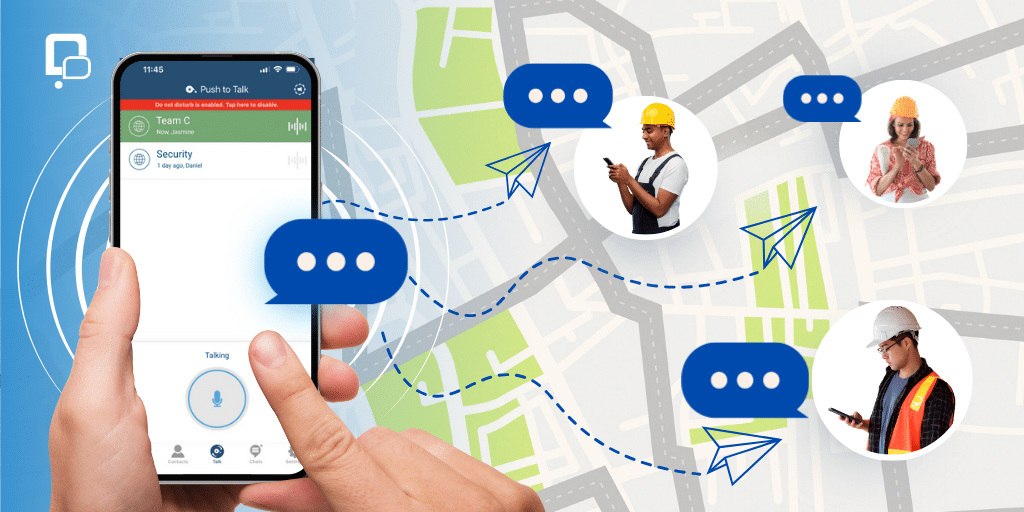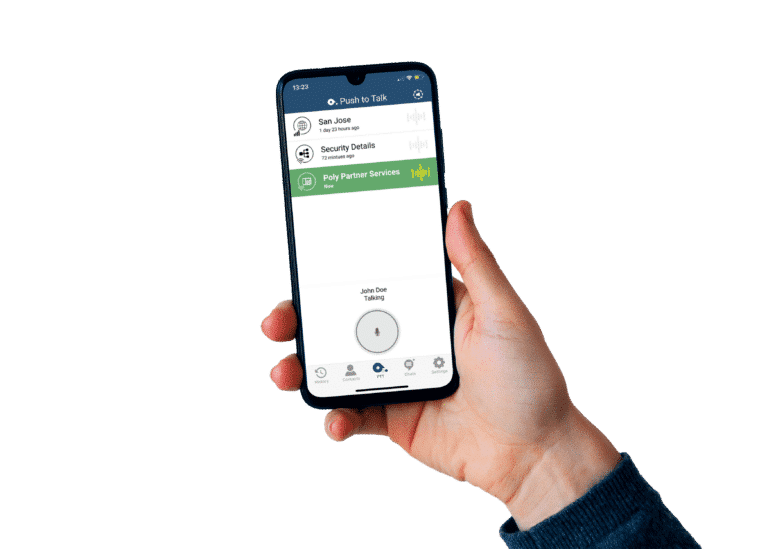Home » Newsroom Posts » The Rise of Push-to-Talk Technology and How It’s Changing Communication

9th August, 2024 | By Shirmattie Seenarine
TL;DR: Discover Push to Talk and How It’s Changing Communication
Push-to-talk offers numerous benefits that can significantly enhance business communication. It is not just another communication channel. It provides one-touch communication with another person or groups of people, which is essential in time-sensitive environments like emergencies or fast-paced settings like manufacturing. Unlike traditional modes of communication, connectivity is instant–just a press of a button. Plus, conversations on modern PTT make it ideal for exchanging sensitive information because they are encrypted with 256-bit AES encryption, so no one can eavesdrop or hijack a communication channel.
In the dynamic landscape of Unified Communications (UC) and Unified Communications as a Service (UCaaS), innovation has been driving enhanced connectivity and productivity. One such innovation that is sparking attention is push-to-talk (PTT) technology. Its integration with modern UC platforms is revolutionizing how businesses communicate.
Push-to-talk offers businesses one-touch voice communication with another person or specific groups. Unlike traditional modes of communication, connectivity is instant. Users do not have to schedule a conference call, wait for participants to join, or dial a phone number. Users press and hold a push-to-talk button and begin speaking. Their voice is transmitted to others on the same frequency or channel. When the button is released, the device reverts to listening mode. This type of data transmission is called half-duplex communication, which means data flows in both directions between two devices but never simultaneously. In other words, data can be sent from Device 1 to Device 2 or from Device 2 to Device 1, but not concurrently. Data that cannot flow in both directions simultaneously prevents conversations from overlapping and ensures clear communication.
Push-to-talk is not a new mode of communication. It is an evolved version of the walkie-talkie that has undergone many changes. PTT technology was initially developed for military forces in World War II to give soldiers immediate and reliable communication on the battlefield. The early systems used amplitude modulation (AM) and frequency modulation (FM). FM gradually replaced AM due to its resistance to noise interference. However, these analog systems had limitations, including restricted range and susceptibility to interference. The introduction of digital PTT, which used digital radio frequencies, marked a significant improvement in audio quality and security, enhancing the user experience. Today, push-to-talk operates over cellular, leveraging LTE, 4G, and 5G, eliminating any range limitations and replacing it with a global reach.

Besides its evolution, there are many other reasons why businesses should consider adopting push-to-talk technology:
Instant Communication
PTT provides instantaneous communication with just a push of a button, which is essential for time-sensitive situations. Whether in a fast-moving industrial setting or an emergency, the ability to communicate immediately can significantly impact outcomes. Dialing a phone number or executing multiple steps to start a conference call is never necessary.
Enhanced Privacy, Coordination, and Collaboration
PTT facilitates group communication. Members can belong to one or many groups, ensuring information remains confidential while allowing teams to coordinate and collaborate more effectively. When a team member communicates over PTT, the information is instantly broadcast to the entire group, ensuring everyone is informed simultaneously. This feature is particularly beneficial in industries where large teams must stay connected across various locations, such as logistics, construction, and event management.
Cost-Effective Solution
Push-to-talk apps can be a more cost-effective solution than the cost of a walkie-talkie radio. Plus, it eliminates the need for multiple devices since it can be downloaded to a user’s smartphone and other devices. Lastly, if a business’ push-to-talk over cellular (PoC) solution can leverage its existing cellular networks, it will further reduce infrastructure costs.
Improved Security
Conversations on modern PTT systems remain confidential because they are encrypted with 256-bit AES encryption, so no one can eavesdrop or hijack a communication channel.
Scalability and Flexibility
Modern push-to-talk solutions are scalable and flexible, making them suitable for businesses of all sizes. PTT systems can be tailored to meet a business’s communication needs, whether a small team or an entire organization. Its integration with various devices and platforms also offers flexibility, allowing companies to adapt to changing requirements and employees to use it on their chosen devices.
Integration
PTT systems can often integrate with other applications to make them more robust. For instance, they can integrate with third-party systems to provide incident notifications and alarms. Many PTT systems also work with specific headsets, producing a layer of privacy for users. In the case of the headset, users can typically press the talk button to start speaking and press it again to stop broadcasting. Additionally, some PTT systems offer recording, which can help many businesses meet compliance requirements or train staff.
5G Advantage
Push-to-talk over cellular can be easily integrated into businesses as it is compatible with many devices, including smartphones and tablets.
The fifth generation of mobile network technology, better known as 5G, is a leap beyond its predecessors, 4G and LTE. 5G offers high-speed data transfer and faster downloads and uploads, essential for real-time collaboration and for companies relying on unified communications (UC) and UCaaS platforms. With employees able to quickly access cloud-based applications and services, downtime is reduced, and productivity increases efficiently.

For businesses considering the adoption of push-to-talk, various devices and platforms are available to integrate this technology into daily operations. Selecting the appropriate devices and platforms can significantly enhance communication efficiency and effectiveness within a company.
Rugged Handheld Devices
A rugged handheld radio is a device dedicated to PTT. These devices are built to endure the harshest conditions, so they are applicable in areas like construction, security, military operation, logistics, and field service. Users depend on these devices because they boast a long battery life and typically offer an assortment of well-being features like GPS tracking.
Smartphones and Tablets
Dedicated push-to-talk apps also referred to as walkie-talkie apps, and business apps with push-to-talk integration are available for iOS and Android devices, transforming smartphones and tablets into powerful PTT communication and collaboration tools that can be used anywhere. Since there are an estimated 8.6 billion mobile subscriptions worldwide, giving people access to this straightforward yet powerful communication channel on their smartphones makes a lot of sense.
Further, combining several ways to communicate (emails, IM, phone calls, PTT) in a single device helps employees organize their communication better and reply on the channel of their choice. It is this type of accessibility that makes 75% of employees believe mobile technology positively impacts their collaboration efforts while allowing more frequent and effective communication.
For companies with employees who carry around multiple work devices like a smartphone and a walkie-talkie and do not need a rugged handheld device, this is an opportunity to integrate a walkie talkie app into employees’ smartphones or tablets, eliminating the need for employees to carry around multiple devices because they now have a push-to-talk phone.
Laptops and Desktops
Push-to-talk (PTT) is often thought of in the context of mobile and handheld devices, but organizations can choose to have PTT software on their laptop or desktop computer for a whole host of reasons:
Wearable Devices
Smartwatches, earpieces, and specialized communication wearables support push-to-talk functionality while offering convenience, mobility, and safety.
Push-to-talk wearables will continue to evolve, expanding their place into many of our everyday tasks. Augmented Reality (AR) glasses like RealWear HMT-1, Vuzix M400, and Google Glass Enterprise Edition 2 devices all support PTT. These wearables have one shared feature: They offer hands-free communication, necessary in industrial sectors where safety or productivity is paramount. Plus, verbal communication can be paired with visual instructions, making it easier to provide remote assistance to workers in the field. Imagine a field technician troubleshooting medical equipment. Visual instructions appear in the worker’s field of view on their AR glasses. The technician does not need a physical manual or handheld device to reference. The technician then performs the work, speaking a command or clicking on his VR glasses to initiate PTT communication with another team member who can guide him through tasks and provide updates. As AR technology fine-tunes itself, expect to also see more sophisticated artificial intelligence (AI) integrations with PTT. AI has great applications that can make these devices more efficient and faster or even enable new functionalities. For instance, AI can provide alerts, identify issues before they occur, and offer proactive guidance, all based on historical data and machine learning.
With its ability to facilitate instant, clear, and reliable communication, push-to-talk is a powerful tool for workers across different industries to leverage. From enhancing operational efficiency to improving safety and coordination, PTT’s unique advantages make it an asset. Here’s how PTT can be embraced across different industries to drive productivity, responsiveness, and collaboration.
Public Safety and Emergency Services
Instantaneous communication can save lives for police, fire departments, and emergency medical services like ambulances. PTT provides a rapid way of communicating during emergencies, allowing first responders to coordinate effectively and make real-time decisions.

Healthcare
From hospitals to nursing homes, a push-to-talk app or device allows staff to communicate quickly and efficiently, improving patient care and saving lives. Whether coordinating between departments or responding to emergencies, the simplicity of pressing a button and the instant nature of PTT ensure that critical information is conveyed without delay to everyone in the PTT group. Moreover, the secure nature of modern PTT systems safeguards patient data, complying with strict healthcare regulations.

Industrial and Commercial Operations
In construction, transportation, and logistics industries, PTT enables seamless coordination among team members who may be dispersed across large geographical areas. Construction workers can communicate site-wide, transport operators can manage fleets efficiently, and logistics teams can ensure smooth supply chain operations. The hands-free options with some PTT systems enhance safety and productivity in these fast-paced environments.

Hospitality and Event Management
In the hospitality and event management industry, push-to-talk enables instant coordination between various departments, such as housekeeping, front desk, security, and event coordination teams. Instant coordination translates into swift responses to guest requests, immediate resolution of issues, and smooth event execution. PTT allows for efficient task management, quick dissemination of critical information, and enhanced teamwork, ultimately leading to improved guest satisfaction and the successful delivery of high-quality services.

Retail
All the members in your push-to-talk group hear the person broadcasting a message the minute the person begins speaking. That might not sound like much until a critical situation unfolds. Now imagine a large fire in a mall where mall security personnel need to get shoppers to evacuate the building. Every security personnel knows the situation unfolding with one button push. It doesn’t matter if some security team members are outside the building, on the first or second floor of the mall, or in the parking garage. They all hear about the crisis simultaneously and react together to get shoppers to safety.

Instant communication through push-to-talk isn’t only important in critical situations. Push-to-talk can improve business success through customer experience. Consider a retail store. Push-to-talk can help improve operational efficiency and eliminate the need for workers to focus their attention on multiple places. For example, a customer is in a shoe store and requests a different size. With PTT, the attendant can ask the employee in the stockroom to bring out the item. The customer requesting a different size is helped immediately, and the floor attendant remains on the floor to assist other shoppers. The salesperson on the floor does not have to go to the stockroom to request a shoe. On the other hand, if the salesperson leaves the customer for an extended period, this could negatively impact customer experience.

While PTT technology offers numerous benefits, some challenges need addressing to ensure success. Here are two of the biggest challenges:
Network Coverage
Businesses must know that PTT communication in areas with poor cellular coverage can be challenging. However, advancements in network technology, such as 5G, are improving coverage and reducing dead zones. Additionally, businesses can seek hybrid systems that combine cellular and radio networks to ensure robust coverage.
Battery Life
PTT communication, mainly when used regularly, can quickly drain a device’s battery. Manufacturers are steadily working on developing more energy-efficient devices, but until then, accessories like extended battery packs and charging docks are an easy workaround.
While some essential push-to-talk services might be free, the comprehensive and feature-rich PTT services businesses use are typically paid add-ons. The enhanced features and capabilities justify the cost. Today, push-to-talk is a vital communication tool transforming industries’ operations. The convergence of PTT with other communication technologies creates more versatile and powerful tools for organizations across various sectors. With digital and PoC systems, PTT offers unparalleled speed, reliability, and functionality. For businesses looking to stay competitive and efficient, adopting push-to-talk is a strategic move that promises significant returns regarding productivity, safety, and operational efficiency.
For more information about push-to-talk, contact Deltapath.